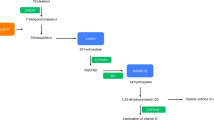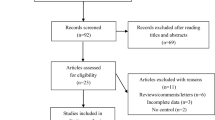Abstract
Purpose
Experimental and epidemiological evidence shows a beneficial role of vitamin D in cancer. In vitro evidence is consistent with a similar protective function in glioma; however, no study has yet examined the potential role of vitamin D in glioma.
Methods
We evaluated the association between common genetic variants in the vitamin D pathway and glioma risk and patient outcome in 622 newly diagnosed glioma cases and 628 healthy controls enrolled in a clinic-based case–control study. Subjects were genotyped for 7 candidate and tagging single nucleotide polymorphisms in the vitamin D receptor and 8 additional variants in NADSYN1, GC, CYP24A1, CYP2R1, and C10ORF88 linked in genome-wide association studies to serum concentrations of vitamin D. Unconditional logistic regression was used to estimate age- and gender-adjusted odds ratios and 95 % confidence intervals for glioma risk according to vitamin D genotypes. Proportional hazards regression was used to estimate hazard ratios for glioma-related death among 320 patients diagnosed with high-grade tumors. P values were uncorrected for multiple comparisons.
Results
Risk of astrocytic tumors was associated with variant alleles in rs3829251 (NADSYN1), rs10741657 (CYP2R1), rs2228570 (Fok1, VDR), and rs731236 (Taq1, VDR). No risk associations were found among oligodendroglial tumors. Survival associations were observed according to variant status for rs1544410 (Bsm1, VDR) and rs6013897 (CYP24A1).
Conclusion
This exploratory analysis provides limited evidence of a role for genetic variation in vitamin D pathway genes with glioma risk and survival.
Similar content being viewed by others
References
Hansen CM, Binderup L, Hamberg KJ, Carlberg C (2001) Vitamin D and cancer: effects of 1,25(OH)2D3 and its analogs on growth control and tumorigenesis. Front Biosci 6:D820–D848
Garland CF, Gorham ED, Mohr SB et al (2007) Vitamin D and prevention of breast cancer: pooled analysis. J Steroid Biochem Mol Biol 103:708–711
Touvier M, Chan DS, Lau R et al (2011) Meta-analyses of vitamin d intake, 25-hydroxyvitamin d status, vitamin d receptor polymorphisms, and colorectal cancer risk. Cancer Epidemiol Biomarkers Prev 20:1003–1016
Freedman DM, Looker AC, Chang SC, Graubard BI (2007) Prospective study of serum vitamin D and cancer mortality in the United States. J Natl Cancer Inst 99:1594–1602
Giovannucci E, Vitamin D (2009) and cancer incidence in the Harvard cohorts. Ann Epidemiol 19:84–88
Helzlsouer KJ (2010) Overview of the cohort consortium Vitamin D pooling project of rarer cancers. Am J Epidemiol 172:4–9
Giovannucci E, Liu Y, Rimm EB et al (2006) Prospective study of predictors of vitamin D status and cancer incidence and mortality in men. J Natl Cancer Inst 98:451–459
Mohr SB, Gorham ED, Garland CF, Grant WB, Garland FC (2010) Low ultraviolet B and increased risk of brain cancer: an ecological study of 175 countries. Neuroepidemiology 35:281–290
Elias J, Marian B, Edling C et al (2003) Induction of apoptosis by vitamin D metabolites and analogs in a glioma cell line. Recent Results Cancer Res 164:319–332
Eyles DW, Smith S, Kinobe R, Hewison M, McGrath JJ (2005) Distribution of the vitamin D receptor and 1 alpha-hydroxylase in human brain. J Chem Neuroanat 29:21–30
Uitterlinden AG, Fang Y, Van Meurs JB, Pols HA, Van Leeuwen JP (2004) Genetics and biology of vitamin D receptor polymorphisms. Gene 338:143–156
Fang Y, van Meurs JB, d’Alesio A et al (2005) Promoter and 3′-untranslated-region haplotypes in the vitamin d receptor gene predispose to osteoporotic fracture: the Rotterdam study. Am J Hum Genet 77:807–823
Wang TJ, Zhang F, Richards JB et al (2010) Common genetic determinants of vitamin D insufficiency: a genome-wide association study. Lancet 376:180–188
Ahn J, Yu K, Stolzenberg-Solomon R et al (2010) Genome-wide association study of circulating Vitamin D levels. Hum Mol Genet 19:2739–2745
Egan KM, Thompson RC, Nabors LB, et al. (2011) Cancer susceptibility variants and the risk of adult glioma in a US case-control study. J Neurooncol
Permuth-Wey J, Thompson RC, Burton Nabors L et al (2011) A functional polymorphism in the pre-miR-146a gene is associated with risk and prognosis in adult glioma. J Neurooncol 105:639–646
Shete S, Hosking FJ, Robertson LB et al (2009) Genome-wide association study identifies five susceptibility loci for glioma. Nat Genet 41:899–904
Wrensch M, Jenkins RB, Chang JS et al (2009) Variants in the CDKN2B and RTEL1 regions are associated with high-grade glioma susceptibility. Nat Genet 41:905–908
Cancer Genome Atlas Research Network (2008) Comprehensive genomic characterization defines human glioblastoma genes and core pathways. Nature 455:1061–1068
Whitfield GK, Remus LS, Jurutka PW et al (2001) Functionally relevant polymorphisms in the human nuclear Vitamin D receptor gene. Mol Cell Endocrinol 177:145–159
Denzer N, Vogt T, Reichrath J (2011) Vitamin D receptor (VDR) polymorphisms and skin cancer: a systematic review. Dermatoendocrinol 3:205–210
Kostner K, Denzer N, Muller CS, Klein R, Tilgen W, Reichrath J (2009) The relevance of vitamin D receptor (VDR) gene polymorphisms for cancer: a review of the literature. Anticancer Res 29:3511–3536
McCullough ML, Bostick RM, Mayo TL (2009) Vitamin D gene pathway polymorphisms and risk of colorectal, breast, and prostate cancer. Annu Rev Nutr 29:111–132
McKay JD, McCullough ML, Ziegler RG et al (2009) Vitamin D receptor polymorphisms and breast cancer risk: results from the National Cancer Institute Breast and Prostate Cancer Cohort Consortium. Cancer Epidemiol Biomarkers Prev 18:297–305
Davies JR, Chang YM, Snowden H et al (2011) The determinants of serum vitamin D levels in participants in a melanoma case-control study living in a temperate climate. Cancer Causes Control 22:1471–1482
Simon KC, Munger KL, Kraft P, Hunter DJ, De Jager PL, Ascherio A (2011) Genetic predictors of 25-hydroxyvitamin D levels and risk of multiple sclerosis. J Neurol 258:1676–1682
Louis DN, Ohgaki H, Wiestler OD et al (2007) The 2007 WHO classification of tumours of the central nervous system. Acta Neuropathol 114:97–109
Acknowledgments
The authors wish to acknowledge study participants for their contributions. We further wish to thank the clinicians and research staffs at participating medical centers. Special thanks go to Celia Sigua and Marek Wloch of the Tissue Core at Moffitt and Cara Sutcliffe of the Center for Human Genetics Research DNA Resources Core at Vanderbilt University School of Medicine for their work in processing DNA samples, and Ms. Anna Konidari and staff at the Center for Genome Technology at the Hussman Institute for Human Genomics, University of Miami for their expert technical assistance in the genotyping phase of the study. This study was supported by a grant from the National Institutes of Health (CA R01CA116174), a cancer prevention fellowship for Gabriella Anic supported by the National Cancer Institute grant R25T CA147832, as well as institutional funding from the Moffitt Cancer Center, Tampa, FL, and the Vanderbilt-Ingram Comprehensive Cancer Center, Nashville, TN.
Conflict of interest
The authors have no conflicts of interest.
Author information
Authors and Affiliations
Corresponding author
Rights and permissions
About this article
Cite this article
Anic, G.M., Thompson, R.C., Burton Nabors, L. et al. An exploratory analysis of common genetic variants in the vitamin D pathway including genome-wide associated variants in relation to glioma risk and outcome. Cancer Causes Control 23, 1443–1449 (2012). https://doi.org/10.1007/s10552-012-0018-7
Received:
Accepted:
Published:
Issue Date:
DOI: https://doi.org/10.1007/s10552-012-0018-7




